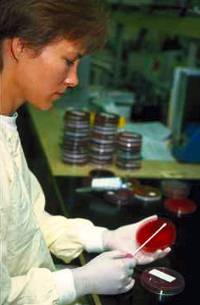11 May 1999
Largest Protein Ever Created from Scratch
 Scientists have been trying to accurately synthesize substances with shapes that mimic biological molecules for some time. A specific goal has been to find proteins that drive important biochemical pathways in human beings. So far, these attempts have only been moderately successful, both in terms of size of the protein designed and the precision with which it folds from a string of amino acids to its final three-dimensional structure. Now, scientists have created the largest protein from scratch, with both a stable and predictable shape. The work was conducted by researchers at the University of Pennsylvania Medical Center.
Scientists have been trying to accurately synthesize substances with shapes that mimic biological molecules for some time. A specific goal has been to find proteins that drive important biochemical pathways in human beings. So far, these attempts have only been moderately successful, both in terms of size of the protein designed and the precision with which it folds from a string of amino acids to its final three-dimensional structure. Now, scientists have created the largest protein from scratch, with both a stable and predictable shape. The work was conducted by researchers at the University of Pennsylvania Medical Center.
"The ability to do this really takes us out of the realm of tinkering with existing proteins to engineering entirely new proteins and polymers," says William F. DeGrado, PhD, professor of biochemistry and biophysics. "We have shown that it is now possible to design a protein with a well-defined three-dimensional structure..
The research notes that implications of this advance in protein design could be as broad as those for natural proteins - from manufacturing completely new polymers for industrial catalysts to creating new pharmaceutical drugs.
To design a protein, scientists generally work backwards from nature in a two-step process. They first choose an existing three-dimensional protein structure and then, using sophisticated computer programs, find a new sequence of amino acids that fold into the same shape as the natural protein. The Penn team's approach is one step removed from that. "We asked: Can we generate proteins that are inspired by nature but have no direct natural equivalent?," explains DeGrado.
The protein - called alpha-3D - was designed, produced, and characterized by Scott Walsh, a doctoral student in DeGrado's lab. Alpha-3D is a bundle of three counterclockwise-coiling helices whose general shape was inspired by a protein found in the common household bacteria Staphylococcus aureus. Alpha-3D is also three times larger than previously synthesized proteins.
"By designing larger proteins, we can make them more stable and thus easier to manipulate," says Walsh. The next step will be to build a specific function into the protein's structure. Currently, Walsh is retooling the surface of alpha-3D to cause it to bind to a variety of hormonal receptors. Natural proteins that do this are expensive to produce and suffer from limited shelf lives. Novel mimics of these proteins may have enhanced stability and potency.
For further information see the University of Pennsylvania Medical Center home page at http://www.med.upenn.edu
